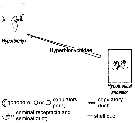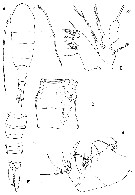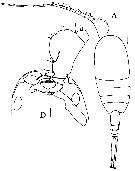|
|
 |
| Hyperbionychidae Ohtsuka, Roe & Boxshall, 1993 ( Arietelloidea ) | | Ref.: | Ohtsuka & al., 1993 (p.70, 78); Cuoc & al., 1997 (p.663: Hyperbionychidae); Ohtsuka & Huys, 2001 (p.461); Boxshall & Halsey, 2004 (p.13, 128); Blanco-Bercial & al., 2011 (p.103, Table 1, Fig.2, 3, 4, Biol. mol, phylogeny); Laakmann & al., 2019 (p.330, fig. 2, 3, phylogenetic relationships)
Bradford-Grieve J.M., (2002 onwards). Key to calanoid copepod families. Version 1 : 2 oct 2002. http://www.crustacea.net/crustace/calanoida/index.htm  | | Rem.: | 2 G: Hyperbionyx, Lamiantennula.
Hyperbenthic forms by great depth. |  Issued from : G.A. Boxshall & S.H. Halsey in An Introduction to Copepod Diversity. The Ray Society, 2004, No 166, Part. I. [p.128]. Armature formula of swimming legs P1 to P4. Nota: Female P5 uniramous, nearly symmetrical; coxae fused to intercoxal sclerite to form common base; basis with outer seta; exopod 1-segmented, armed with 2, 1, 2 elements. - Male P5 uniramous, asymmetrical; right leg coxa fused to intercoxal sclerite; basis with posterior seta and inner process possibly representing endopod; exopod 3-segmented with distal 2 segments partly fused and lamellate. Left leg coxa incompletely fused to intercoxal sclerite; basis expanded anteriorly, with posterior seta and inner angle process (? endopod); exopod 3-segmented, segments 1 and 2 each with 1 spine, segment 3 curved, bearing 1 seta and 2 plate-like elements | | | | | (1) Hyperbionyx Ohtsuka, Roe & Boxshall, 1993 | |
| | Ref.: | Ohtsuka & al., 1993 a (p.70, Def.); Mauchline, 1998 (p.73: F; p.74: M); Cuoc & al., 1997 (p.651, Fig.6: female genital area); Bradford-Grieve,1999 b (p.70, Def.); Bradford-Grieve, 2004 (p.287); Boxshall & Halsey, 2004 (p.128); Bradford-Grieve, 2010 (p.2167) | | Rem.: | Total: 2 spp. | | Remarques sur les dimensions et le sex-ratio: | | The mean female size is 10.40 mm and the mean male size is 8.66 mm. The size ratio (male : female) is 0.833. The sex ratio is 0.5 temporary. |  issued from :C. Cuoc, D. Defaye, M. Brunet, R. Notonier & J. Mazza in Mar. Biol., 1997, 129. [p.13, Fig.6]. Diagrammatic representation of main evolutionary trends in organization of female genital area in calanoïds for Hyperbionyx (modified after Huys & Boxshall, 1991 and Ohtsuka & al., 1994). |
 Issued from : G.A. Boxshall & S.H. Halsey in An Introduction to Copepod Diversity. The Ray Society, 2004, No 166, Part. I. [p.129, Fig.26]. Hyperbionyx pluto: A, hanitus female; B, female Mx2; C, female Mx1; D, female genital-double-somite; E, male urosome; [Ohtsuka, Roe & Boxshall, 1993]. | | | | | (2) Lamiantennula Markhaseva & Schulz, 2006 | |
| | Ref.: | Markhaseva & Schulz, 2006 b (p.204); Bradford-Grieve, 2010 (p.2171, Rem.); Renz & Markhaseva, 2015 (p.96, Table 4, fig.3, sex ratio, biogeography) | | Rem.: | Total: 1 sp. | | Remarques sur les dimensions et le sex-ratio: | | Length of body size for one female only: 3.70 mm. By great depth and with a great difference of size by comparison with the genus Hyperbionyx. |  Issued from : E.L. Markhaseva & K. Schulz in Arthropoda Selecta, 2006, 15 (3). [p.205, Fig1, A, D]. Lamiantennula longifurca female: A, habitus, dorsal view; D, anterior part of cephalosome, ventral viw, showing rostrum, labrum, mandibular gnathobase and proximal segments (ancestral segments I-III) of left antennule. Scale bars: 0.5 mm (A); 0.1 mm (D). Specimen from the Weddell Sea (64°02 'S, 39°07' W), above the sea bed at 4748-4743 m. Nota: Lamelliform complex of ancestral segments I-III expanded anteriorly and dorso-ventrally compressed; with 2 setae + 1 aesthetasc, 2 setae, 2 setae + 1 aesthetasc; segment IV with 2 setae; segment V with 2 setae + 1 aesthetasc. | | | | | | |
|
|
 Toute utilisation de ce site pour une publication sera mentionnée avec la référence suivante : Toute utilisation de ce site pour une publication sera mentionnée avec la référence suivante :
Razouls C., Desreumaux N., Kouwenberg J. et de Bovée F., 2005-2025. - Biodiversité des Copépodes planctoniques marins (morphologie, répartition géographique et données biologiques). Sorbonne Université, CNRS. Disponible sur http://copepodes.obs-banyuls.fr [Accédé le 17 novembre 2025] © copyright 2005-2025 Sorbonne Université, CNRS
|
|
 |
 |






